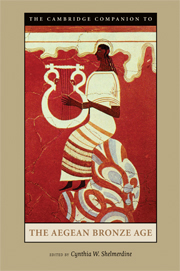Book contents
- Frontmatter
- 1 Background, Sources, and Methods
- 2 The Early Bronze Age in Greece
- 3 The Early Bronze Age in the Cyclades
- 4 Early Prepalatial Crete
- 5 Protopalatial Crete
- 6 The Material Culture of Neopalatial Crete
- 7 Minoan Culture: Religion, Burial Customs, and Administration
- 8 Minoan Crete and the Aegean Islands
- 9 Minoan Trade
- 10 Early Mycenaean Greece
- 11 Mycenaean Art and Architecture
- 12 Mycenaean States
- 13 Burial Customs and Religion
- 14 Mycenaean Greece, the Aegean and Beyond
- 15 Decline, Destruction, Aftermath
- Glossary
- Select Bibliography
- Index
- Plate section
7 - Minoan Culture: Religion, Burial Customs, and Administration
Published online by Cambridge University Press: 28 November 2010
- Frontmatter
- 1 Background, Sources, and Methods
- 2 The Early Bronze Age in Greece
- 3 The Early Bronze Age in the Cyclades
- 4 Early Prepalatial Crete
- 5 Protopalatial Crete
- 6 The Material Culture of Neopalatial Crete
- 7 Minoan Culture: Religion, Burial Customs, and Administration
- 8 Minoan Crete and the Aegean Islands
- 9 Minoan Trade
- 10 Early Mycenaean Greece
- 11 Mycenaean Art and Architecture
- 12 Mycenaean States
- 13 Burial Customs and Religion
- 14 Mycenaean Greece, the Aegean and Beyond
- 15 Decline, Destruction, Aftermath
- Glossary
- Select Bibliography
- Index
- Plate section
Summary
Religion and Cult Practice
In the modern world, Western societies tend to separate religion and ritual from other aspects of society in a way that ancient or “primitive” societies did not. In ancient cultures religion was an integral part of daily life, including the treatment of the deceased after death. For a heavily agrarian society, cult practice centered on daily and seasonal activities and on human involvement with a perceived supernatural world. Although it is difficult to reconstruct belief systems without documentary evidence (below, pp. 173-82), the archaeological record preserves much evidence for ritual equipment and activities. What makes Minoan society interesting, as well as difficult for us to understand, is the apparent overlap between religion, society, and politics. Some of these issues have been addressed in detail, but no consensus has emerged among scholars - an impossibility, perhaps, in any discussion of religion!
We assume that the foundations of Neopalatial religion were laid in the Protopalatial period, and probably much earlier, in the form of cults at caves (some at quite remote locations), at sanctuaries on mountain peaks throughout the island where offerings were made of terracotta human and animal figures, and at communal tombs, often deliberately situated to provide easy access from the homes of the living (Ch. 4, p. 93).
- Type
- Chapter
- Information
- The Cambridge Companion to the Aegean Bronze Age , pp. 165 - 185Publisher: Cambridge University PressPrint publication year: 2008
- 4
- Cited by

